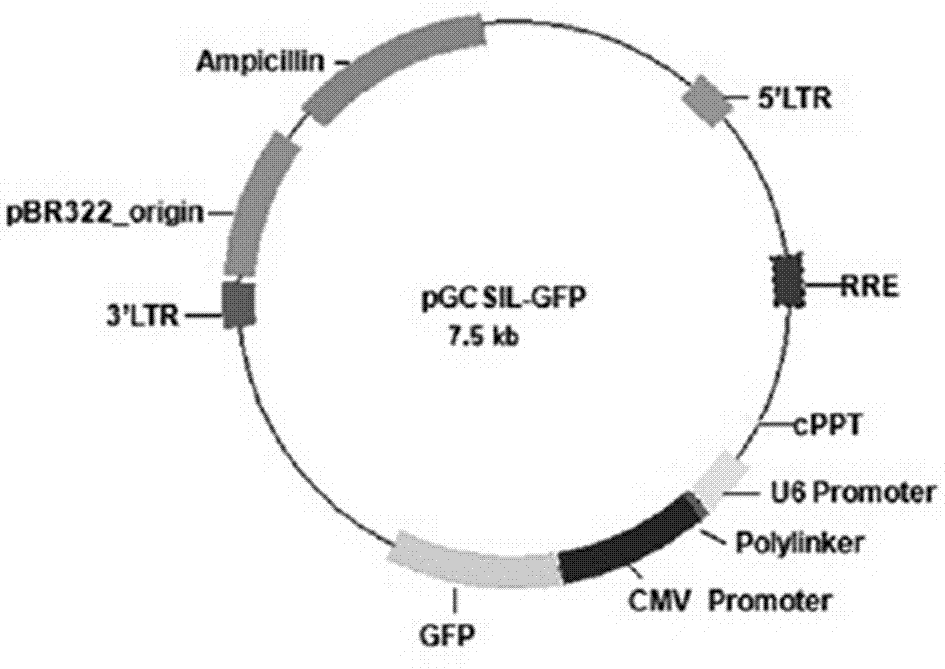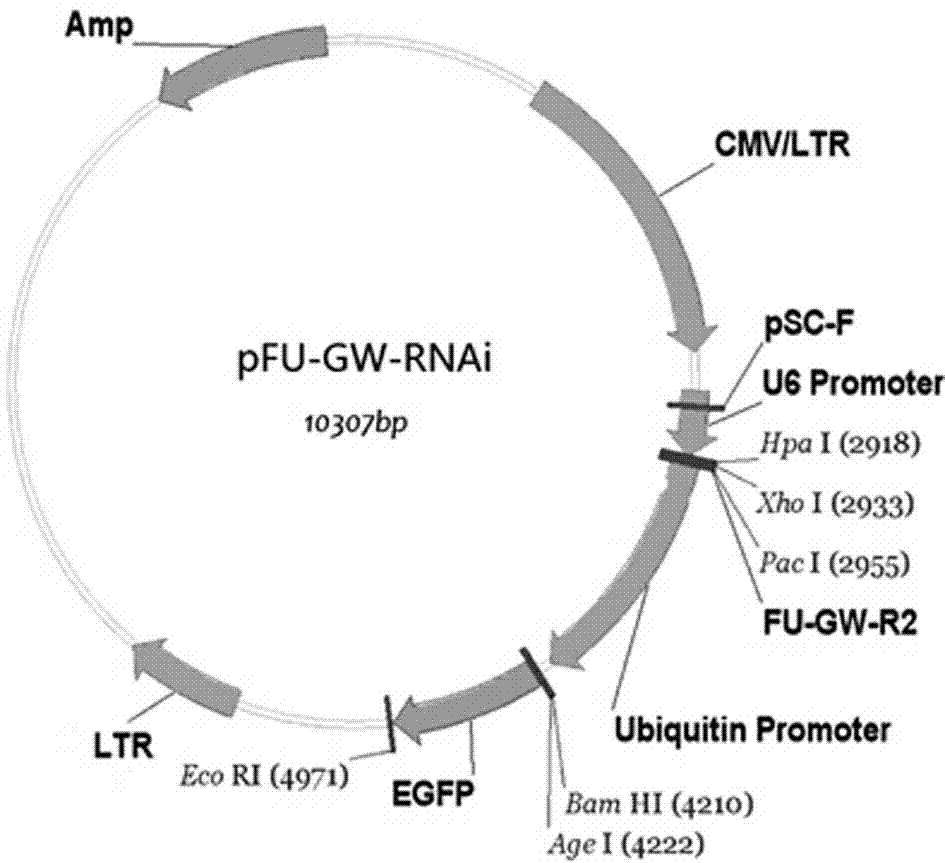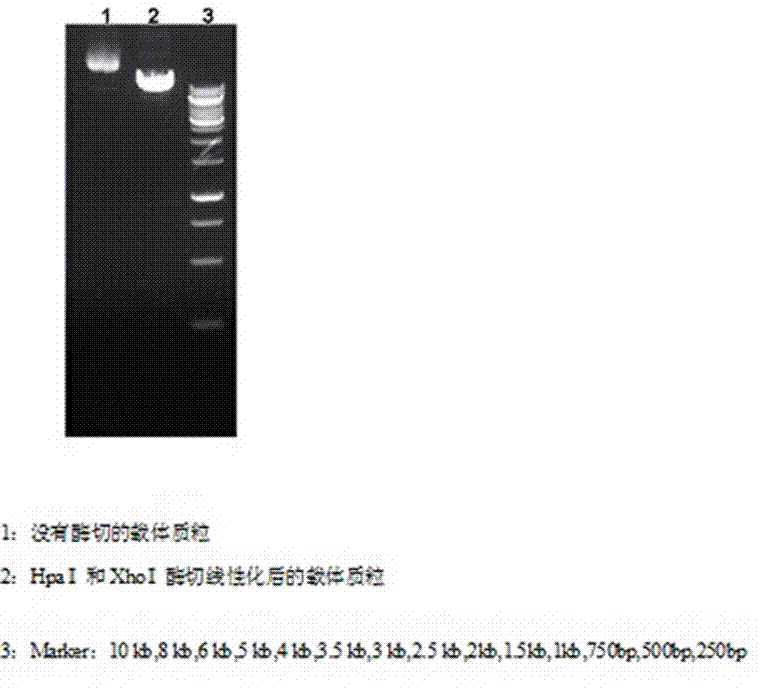ShRNA (Short Hairpin Ribonucleic Acid) kit for treating animal model suffered from alzheimer disease
An Alzheimer's disease, animal model technology, applied in gene therapy, microbial assay/test, preparations for in vivo tests, etc., can solve the problem of lack of shRNA gene reagents suitable for Alzheimer's disease treatment, etc. To achieve the effect of convenient inhibition, inhibition of gene expression, reduction of apoptosis and necrosis
- Summary
- Abstract
- Description
- Claims
- Application Information
AI Technical Summary
Problems solved by technology
Method used
Image
Examples
Embodiment 1
[0029] Example 1: Design and synthesis of specific shRNA sequences.
[0030] According to the caspase-3 gene sequence (NM_009810), the caspase-3 gene-specific siRNA sequence was designed using Ambion's RNA interference design software as follows:
[0031] Sense strand: 5'-GAGTCTGACTGGAAAGCCGAA-3'
[0032] Antisense strand: 5'-TTCGGCTTTCCAGGAAGACTC-3'.
[0033] And through BLAST homology analysis, the possibility of non-specific inhibition of other gene sequences was ruled out.
[0034] The sequences of caspase-3 siRNA and its negative control are:
[0035] Gene species 5' to 3' sequence GC% caspase-3 siRNA the mouse GAGTCTGACTGGAAAGCCGAA 52.63% Negative control siRNA the mouse GAACGTGACACGTTCGGAGAA 55.32%
[0036] Based on the pGCsiL-GFP vector ( figure 1 ) Multiple cloning sites, designed at both ends of the shRNA fragment Age I and Eco R I enzyme cutting site, determine the caspase-3 gene-specific shRNA sequence as:
[0037...
Embodiment 2
[0043] Example 2: Construction of RNA interference lentiviral plasmid vector.
[0044] 1. Construction of shRNA plasmid vector
[0045] through Hpa I and xho I double enzyme digestion recovery pFU-GW-RNAi vector ( figure 2 ) to make it linear, the enzyme digestion reaction system is:
[0046] Purified DNA plasmid (1 μg / μL) 2μL 10×buffer 5μL 100×BSA 0.5μL Hpa I (10 U / μL) 1μL xho I (10 U / μL) 1μL h 2 o 40.5μL total 50μL
[0047] Place the above mixed reactant at 37°C for 1 h, see the results of the enzyme digestion reaction image 3 .
[0048] 2. Competent state preparation:
[0049] Prepare fresh E. coli DH5α competent cells with calcium chloride:
[0050] 1) Pick a DH5α single colony from a fresh plate cultured at 37°C for 16h, transfer it to a 1L flask containing 100mL of LB or SOB medium, and culture it at 37°C for 3h with vigorous shaking (rotary shaker, 300 rpm min);
[0051] 2) Under aseptic condi...
Embodiment 3
[0086] Example 3: Lentiviral packaging.
[0087] The lentiviral packaging system consists of three plasmid vectors pGC-LV ( Figure 5 ), pHelper 1.0 ( Image 6 ), pHelper 2.0 ( Figure 7 ) composition, high-purity endotoxin-free extraction of the three plasmid vectors, and co-transfection of 293T cells according to the instructions of Invitrogen Lipofectamine 2000. After 8 hours of transfection, the complete medium was replaced. After 48 hours of culture, the collection of slow The cell supernatant of the virus particles was concentrated to obtain a high-titer lentivirus concentrate, and the virus titer was measured and calibrated in 293T cells. Lentiviral particles within a certain titer range can meet the needs of most in vivo and in vitro experiments.
[0088] Lentiviral packaging cells 293T are anchorage-dependent epithelioid cells, and the growth medium is DMEM (containing 10% FBS), 37°C, 5% CO 2 Cultivated in an incubator, the adherent cells grow and proliferate to f...
PUM
| Property | Measurement | Unit |
|---|---|---|
| diameter | aaaaa | aaaaa |
Abstract
Description
Claims
Application Information
 Login to View More
Login to View More - Generate Ideas
- Intellectual Property
- Life Sciences
- Materials
- Tech Scout
- Unparalleled Data Quality
- Higher Quality Content
- 60% Fewer Hallucinations
Browse by: Latest US Patents, China's latest patents, Technical Efficacy Thesaurus, Application Domain, Technology Topic, Popular Technical Reports.
© 2025 PatSnap. All rights reserved.Legal|Privacy policy|Modern Slavery Act Transparency Statement|Sitemap|About US| Contact US: help@patsnap.com



